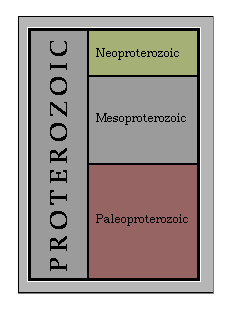Introduction to the Proterozoic Era
2.5 billion to 543 million years ago
The period of Earth's history that began 2.5 billion years ago and ended 543
million years ago is known as the Proterozoic. Many of the most exciting
events in the history of the Earth and of life occurred during
the Proterozoic -- stable continents first appeared and began to accrete,
a long process taking about a billion years. Also coming from this time
are the first abundant fossils of living organisms, mostly
bacteria and archaeans,
but by about 1.8 billion years ago eukaryotic cells appear as fossils too.
With the beginning of the Middle Proterozoic comes the first evidence of
oxygen build-up
in the atmosphere. This global catastrophe spelled
doom for many bacterial groups, but made possible the explosion
of eukaryotic forms. These include multicellular algae, and toward the
end of the Proterozoic, the first animals.
Click on the buttons below to learn more about the Proterozoic.



 |
Subdivisions of the
Proterozoic:
The chart at left shows the three major subdivisions of the Proterozoic Era.
These divisions are somewhat arbitrary, and we have not attempted to
prepare exhibits on each of them. We do have a nice exhibit on the
Vendian, the last portion of the
Neoproterozoic.
The Proterozoic Era occurs between the
Archaean and the
Paleozoic.
|
Visit Joe Meert's Paleomagnetism
Home Page for the latest information on Precambrian continent reconstructions.
Caltech Paleomagnetics Laboratory
presents a summary of research into Neoproterozoic
paleogeography.
Read about the Llano uplift
in central Texas, which is also of Proterozoic age.
Find out more about the Precambrian paleontology and geology of North America at the Paleontology Portal.









